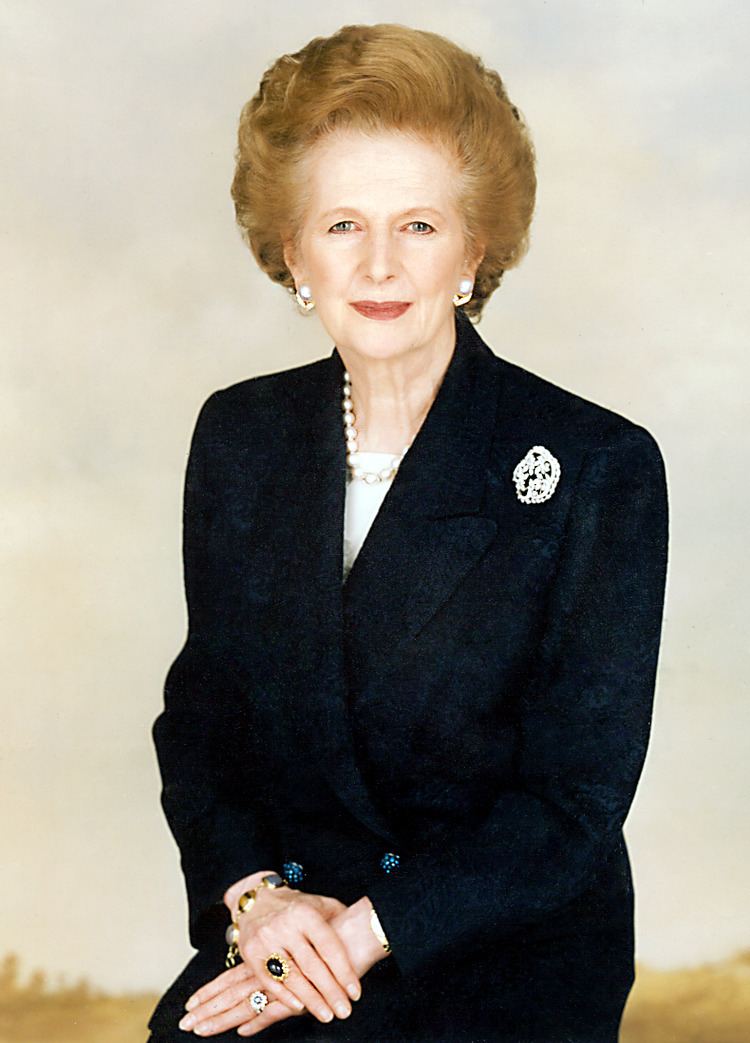Date formed 4 May 1979 | Date dissolved 9 June 1983 Deputy head of government William Whitelaw | |
 | ||
Margaret Thatcher was Prime Minister of the United Kingdom from 4 May 1979 to 28 November 1990, during which time she led a Conservative government. She was the first woman to hold that office. During her premiership, Thatcher moved to liberalise the British economy through deregulation, privatisation, and the promotion of entrepreneurialism. This article details the First Thatcher ministry, which existed from 1979 until 1983.
Contents
Formation
Following the vote of no confidence against the Labour government and prime minister James Callaghan on 28 March 1979, a general election was called for 3 May 1979. The Winter of Discontent had seen the Labour government's popularity slump during the previous four months, and the opinion polls all pointed towards a Conservative victory.
The Tories won the election with a majority of 44 seats and their leader Margaret Thatcher became Britain's first female prime minister.
Thatcher inherited some of the worst economic statistics of postwar Britain. The nation was still feeling the effects of the numerous strikes during the recent Winter of Discontent. Inflation had recently topped 20%, and unemployment was in excess of 1.5 million for the first time since the 1930s.
Thatcher's monetarist and deflationary economic policies saw a cut in the inflation rate from a high of 22% in May 1980 to just over 13% by January 1981, and by June 1983 it had fallen to a 15-year low of 4.9%.
She also oversaw union reforms which saw strikes at their lowest for 30 years by 1983. However, her economic policies also resulted in the loss of much of Britain's heavy industry. Coal pits, steel plants, machine-tools and shipyards were particularly hard hit, most of all in Scotland, Northern Ireland and the north of England. By 1983, unemployment had reached 3.2 million, although economic growth was now re-established following the recession of 1980 and 1981.
The Labour opposition, which changed leader from James Callaghan to Michael Foot in 1980, was in no position to exploit the situation and mount a threat to the Conservative government's power. The change of leader saw the party shift dramatically to the left, and in 1981 a host of disenchanted Labour MP's formed the breakaway Social Democratic Party. The new party swiftly formed an alliance with the Liberals with a view to forming a coalition government at the next election. Roy Jenkins, leader of the SDP, worked in conjunction with Liberal leader David Steel with the goal of forming a coalition government at the next general election. For a while, opinion polls suggested that this could happen, with support for the Alliance peaking at 50% in late 1981, with both the Tories and Labour faring dismally.
However, when the Falkland Islands (a British colony in the South Atlantic) were seized by Argentine forces in March 1982, Thatcher was swift to declare war on Argentina which was won on 14 June when the Argentines surrendered. The success of this campaign saw a swift turnaround in support for the Tory government, who by the summer of 1982 were firmly in the lead in all of the major opinion polls. A Conservative victory at the next election appeared inevitable, although it appeared far from clear whether it would be Labour or the Alliance who formed the next opposition.
Fate
Thatcher had the option of waiting until May 1984 before calling a general election, but the opinion polls remained in her favour as 1983 dawned and so she called a general election for 9 June. With all the pollsters pointing towards a Tory majority, the most interesting outcome of the election was the guessing game as to whether it would be Labour or the Alliance who formed the next opposition.
In the event, the Tories were re-elected with a 144-seat majority. The election was an unmitigated disaster for Labour, who polled a mere 27.6% of the vote and were left with just 209 MPs in the new parliament. The Alliance came close to Labour in terms of votes with 25.4% of the electorate voting for them, but won a mere 23 seats.
May 1979 to September 1981
Changes
September 1981 to June 1983
In September 1981, a substantial reshuffle took place.
Changes
List of Ministers
Members of the Cabinet are in bold face.
